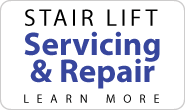
In the world of stairlift manufacturing, there are two types of drive motors which currently dominate the industry: rack and pinion drives, and cables drives. A lot of misinformation has been disseminated about both types of drive motors. Let's take a closer look at how both of these drive types work and examine the myths that have sprung up around them.
Rack and pinion stair lift motors operate on much the same principle as the steering mechanism in modern automobiles. A pinion, or circular gear, is made to fit into a corresponding rack, or gear bar; as the pinion is rotated, the rack travels in the direction of the rotational force. For example, in most cars, the pinion is attached to the base of the steering column, and as the driver turns the steering wheel, the column and pinion cause the rack to move left or right, which makes the wheels move from side to side. A rack and pinion stair lift operates in the same way: as the pinion rotates, the rack moves in the appropriate direction along the lift track, conveying the lift seat and rider along the track.
Cable drive motors, also sometimes referred to as drum and cable drives or winch drives, are operated by a drum winch that rotates to make the attached cable wind around the drum, pulling the stair lift upward along the track. Downward travel simply requires the drum to rotate in the other direction, and the lift travels back down the stairs as the cable is unwound.
One common concern voiced by people who disdain cable drive stair lifts is that a serious mishap can occur if the cable snaps. While this would certainly be an awful thing for a stair lift user, the reality is that it's a highly unlikely occurrence. AmeriGlide stair lifts, for instance, utilize aircraft-grade cable that is rated to safely support 4,200 pounds of weight – more than two tons. This doesn't mean that the stairlift is actually rated for that much weight, of course; a stairlift's absolute weight capacity is affected by several other factors besides the tensile strength of the cable, including the strength of the lift seat and the type of track used. But the probability of such heavy-duty cable snapping in a drum and cable drive system is minuscule – you're more likely to get hit by lightning on February 29th in a leap year. Furthermore, this is the same type of cable used to operate most elevators, which have to handle weight loads much heavier than a stair lift unit does. Even a cursory look at incidence reports tells us that cable malfunctions in modern elevator systems are very nearly unheard of.
Cable drive stairlifts are also said to be louder and jerkier than rack-and-pinion stair lifts, and this observation was probably true in the early days of cable drive systems. However, in recent years, technological advances in the design of cable drive stair lifts, particularly the engineering of the winding drum mechanisms used to power them, have made this complaint nearly obsolete. Additionally, a rack and pinion stair lift will almost always contain a circuit board that is necessary for the unit to operate. Circuit boards are sensitive to dust and vibration, both of which are nearly unavoidable side effects of long-term stairlift use; not only that, but a power surge can also destroy the circuit board and render the unit useless until a replacement part can be ordered and installed. When shopping for a stair lift, it is ultimately up to the consumer as to whether a barely noticeable increase in smoothness and decrease in noise is worth the tradeoff of the chance that a circuit board will go bad at some point down the road.
One myth about rack and pinion stair lift systems that isn't true, though, is that they universally require more maintenance than cable driven stairlift units. Most modern day rack and pinion stair lifts feature a sealed gear box that contains the necessary lubricants and requires no maintenance over the lifetime of the machine. However, cable drive stairlifts are mostly maintenance-free as well – generally all that needs to be done is to grease the track twice a year to ensure smooth operation.
The debate over which sort of drive system is a better buy for the end user is not likely to end so long as different manufacturers are utilizing different drive types and different distributors are charged with selling them; it is this competition which has fanned the flames of the debate for so long. Ultimately, though, both rack and pinion motors and cable drive motors work perfectly fine in practice. They each have unique advantages and disadvantages, but the reality is that a stair lift is only as good as the company that makes it, and a manufacturer who acts with their customers' best interests at heart can make a safe, high-quality stair lift with either type of drive system.

